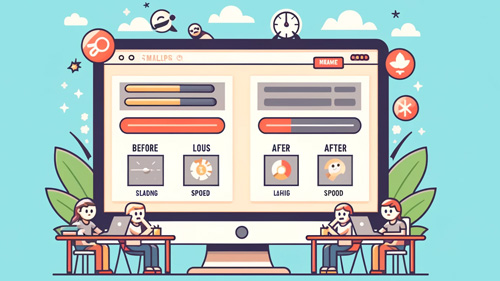Website Wins: Effective Ways to Reduce Bounce Rates and Attract More Visitors
Sunday, December 1st, 2024

Do your website visitors seem to vanish almost as quickly as they arrive? If you’re facing this challenge, it’s time to rethink how you engage with your audience. A high bounce rate can hinder your site’s performance, suggesting that visitors might not be finding what they expected or that the website does not engage them enough to stay. Fortunately, with the right strategies, you can transform your site into a more captivating and visitor-friendly place. Let’s explore some proven tactics that can help keep your visitors interested longer, enhancing both their experience and your site’s effectiveness.
Decoding Bounce Rates: Insights Into Visitor Behavior
Why should you care about your website’s bounce rate? A high bounce rate often signals that your site’s landing pages aren’t effective at capturing visitor interest or encouraging further exploration. This metric is crucial for understanding how well your site meets visitor expectations and retains their attention. High bounce rates can result from several factors, including misleading title tags and meta descriptions, poor design, slow loading times, or content that doesn’t resonate with the target audience. Addressing these can dramatically improve how visitors perceive and interact with your site. A deeper dive into analytics can show you the sources of your traffic and the pages with the highest bounce rates, guiding you to where improvements are most needed.
Creating a Captivating First Impression: Design and User Experience
How impactful is your website’s design on visitor retention? The design of your website plays a pivotal role in forming first impressions. An outdated or confusing website layout can turn visitors away, while a modern, clean, and engaging design can draw them in. Paying attention to aesthetic elements like color schemes, typography, and overall layout not only pleases the eye but also enhances usability. Incorporating user-friendly navigation and responsive design ensures that users on any device have a positive experience. Furthermore, adding interactive elements like hover effects and dynamic content can make your website not only functional but also fun to explore. It’s all about making your visitors feel comfortable and intrigued enough to stick around and discover more.
Delivering Value Through Content: Engage and Educate
Are you effectively capturing your audience’s attention with your content? The content on your site should immediately communicate value and relevance to your audience’s interests or needs. Start with compelling headlines that promise answers to common questions or solutions to problems. Then, use a narrative style in your articles to guide visitors through your content, keeping them engaged with stories or case studies that illustrate your points. High-quality, original content that is regularly updated can significantly decrease your bounce rate. Include visual content such as images, videos, and infographics to break up text and add value, making the user’s visit both informative and enjoyable. Remember, content that educates or entertains is more likely to be shared, extending your site’s reach and reducing bounce rate over time.
Enhancing Site Interaction: Make It a Two-Way Street
How can making your website interactive reduce your bounce rate? Interactive elements on a website do more than entertain; they make your visitor’s experience personalized and memorable. Features like quizzes, interactive assessments, or engaging polls encourage active participation rather than passive reading. This not only makes the experience more enjoyable but also increases the likelihood that visitors will convert, remember your site, and return. Tailoring interactive content to visitor preferences using data from their browsing patterns can make interactions even more engaging. This strategy transforms your website from a static information repository into a dynamic platform that fosters a sense of community and loyalty.

Optimizing for All Devices: Seamless Accessibility
Is your website optimized for every visitor, regardless of their device? In today’s digital age, mobile traffic often surpasses desktop traffic, making mobile optimization crucial for reducing bounce rates. A site that loads quickly and displays well on mobile devices can keep visitors engaged longer. Responsive design adapts to different screen sizes and orientations, providing a seamless user experience across all devices. Additionally, optimizing for touch interactions on mobile devices, such as easy-to-tap buttons and swipe-friendly carousels, can greatly enhance usability and satisfaction. Regular testing on various devices ensures your website remains accessible and enjoyable for every visitor, thereby encouraging longer visits and deeper engagement.
Guiding Visitors with Clear Calls to Action: Next Steps Made Simple
Do your visitors know what to do after landing on your page? Effective calls to action (CTAs) are essential for guiding visitors through your website and encouraging them to take desired actions. Each page should have a clear CTA that stands out, whether it’s to subscribe to a newsletter, start a free trial, or read another article. These CTAs should be strategically placed to catch the user’s attention at the right moment, ideally just as they have gleaned valuable information from your content. Well-crafted CTAs can transform passive browsing into active engagement, significantly reducing your site’s bounce rate and increasing the chances of conversion.
Scale your web presence without spending: join a free traffic exchange network for reliable audience growth.

Just imagine your website as a cozy, inviting place where every visitor feels valued and eager to explore. By applying these strategies, you create a welcoming space that not only meets visitors’ needs but also exceeds their expectations. As you enhance your site, remember that each small improvement can make a big difference in how long visitors stay and how often they return. You’re not just reducing bounce rates; you’re building a vibrant community around your content, where every click brings them closer to you.
Filed under: Tips & Tricks
Exclusive Offer!
1,500,000 Points for $110 $68. If you're running low on points — don't miss out
limited time